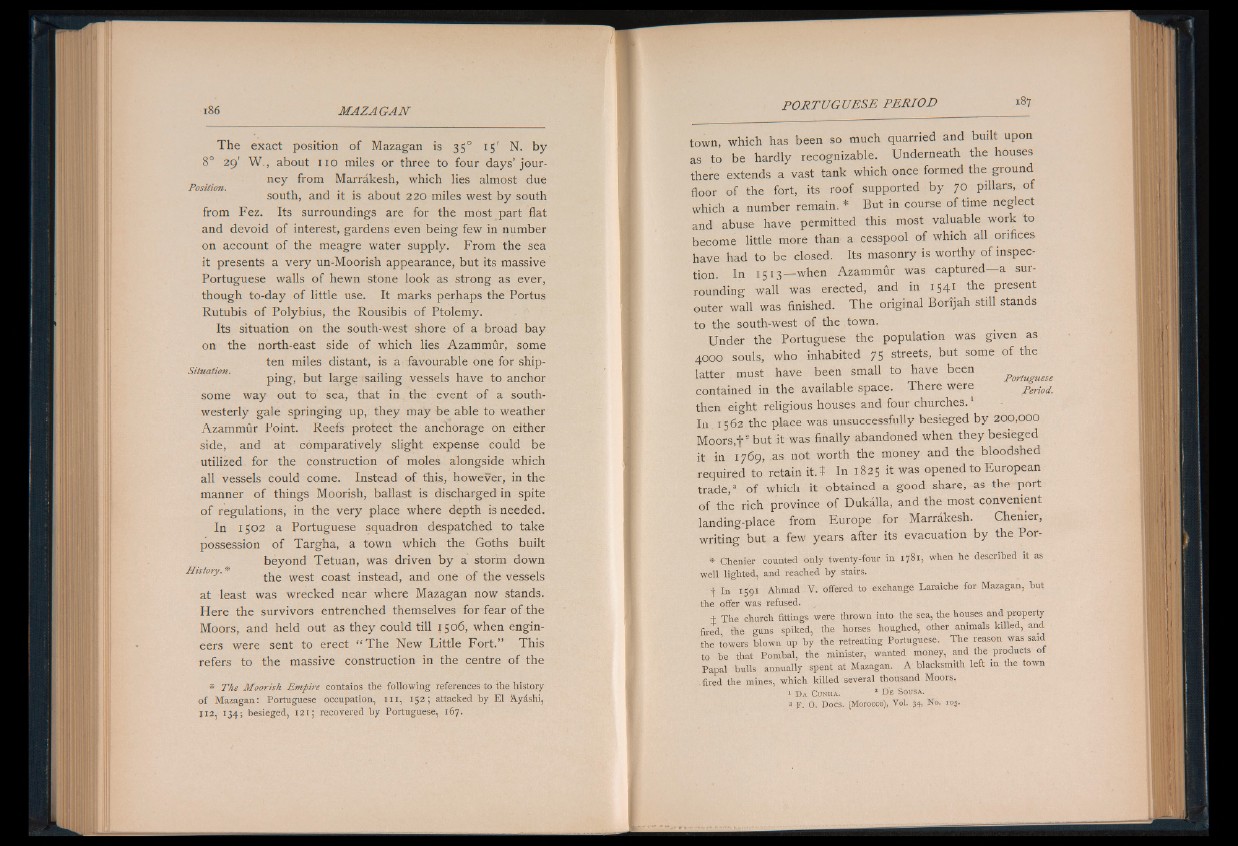
The exact position of Mazagan is 350 15' N. by
8° 29' W., about n o miles or three to four days’ journey
from Marrakesh, which lies almost due
Position.
south, and it is about 220 miles west by south
from Fez. Its surroundings are for the most part flat
and devoid of interest, gardens even being few in number
on account of the meagre water supply. From the sea
it presents a very un-Moorish appearance, but its massive
Portuguese walls of hewn stone look as strong as ever,
though to-day of little use. It marks perhaps the Portus
Rutubis of Polybius, the Rousibis of Ptolemy.
Its situation on the south-west shore of a broad bay
on the north-east side of which lies Azammur, some
ten miles distant, is a favourable one for shipping,
but large sailing vessels have to anchor
some way out to sea, that in the event of a southwesterly
gale springing up, they may be able to weather
Azammur Point. Reefs protect the anchorage on either
side, and at comparatively slight expense could be
utilized for the construction of moles alongside which
all vessels could come. Instead of this, however, in the
manner of things Moorish, ballast is discharged in spite
of regulations, in the very place where depth is needed.
In 1502 a Portuguese squadron despatched to take
possession of Targha, a town which the Goths built
beyond Tetuan, was driven by a storm down
History. west coast instead, and one of the vessels
at least was wrecked near where Mazagan now stands.
Here the survivors entrenched themselves for fear of the
Moors, and held out as they could till 1506, when engineers
were sent to erect “ The New Little Fort.” This
refers to the massive construction in the centre of the
* The Moorish Empire contains the following references to the history
of Mazagan: Portuguese occupation, h i , 152; attacked by El Aydshi,
XI2, 134; besieged, 121; recovered by Portuguese, 167.
town, which has been so much quarried and built upon
as to be hardly recognizable. Underneath the houses
there extends a vast tank which once formed the ground
floor of the fort,, its roof supported by 70 pillars, of
which a number remain. * But in course of time neglect
and abuse have permitted this most valuable work to
become little more than a cesspool of which all orifices
have had to be closed. Its masonry is worthy of inspection.
In 1513— when Azammur was captured a surrounding
wall was erected, and in 1541 the present
outer wall was finished. The original Borijah still stands
to the south-west of the town.
Under the Portuguese the population was given as
4000 souls, who inhabited 75 streets, but some of the
latter must have been small to have been Portuguese
contained in the available space. There were Period.
then eight religious houses and four churches.
In 1562 the place was unsuccessfully besieged by 200,000
Moors,f2 but it was finally abandoned when they besieged
it in 1769, as not worth the money and the bloodshed
required to retain it. t In 1825 it was opened to European
trade,3 of which it obtained a good share, as the port
of the rich province of Dukalla, and the most convenient
landing-place from Europe for Marrakesh. Chenier,
writing but a few years after its evacuation by the Por-
* Chenier counted only twenty-four in 1781, when he described it as
well lighted, and reached by stairs.
t In 1591 Ahmad V. offered to exchange Laraiche for Mazagan, but
the offer was refused.
+ The church fittings were thrown into the sea, the houses and property
fired the guns spiked, the horses houghed, other animals killed, and
the towers blown up by the retreating Portuguese. The reason was said
to be that Pombal, the minister, wanted money, and the products of
Papal bulls annually spent at Mazagan. A blacksmith left m the town
fired the mines, which killed several thousand Moors.
1 D a C u n h a . 2 D e S o u s a .
3 p, o . Po e s . (Morocco), Vol. 34, No. 105.